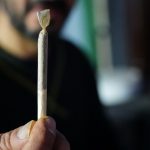U.S, May 07, 2021 (ANALYTICAL CANNABIS) For a professional cannabis cultivator, Christian Hald Madsen hasn’t had a typical career. Unlike many of his counterparts in North America, he didn’t start out in a home-grown cannabis operation or even a high-ranking pharmaceutical company. He was breeding roses.
“I am from the horticulture industry,” he tells Analytical Cannabis. “With cannabis, we look at it as something that we think we can improve, plant wise. We’ve done it a lot with roses – growth habits, mildew resistance, etc. So that’s our approach with cannabis.”
Madsen is the CEO of Ventura, a medical cannabis cultivator based in Fredensborg, Denmark. And like many in the country’s emerging medical marijuana sector, Madsen and his colleagues are looking to bring their practices of mass ornamental flower cultivation to the world of cannabis.
“We’re interested in the plant size and then supplying a lot of different profiles to the market, but with the same habits,” says Madsen. “So, they can be grown in an industrial way.”
“With roses, [if] you have ten colors, but they grow exactly the same, you can sell them at exactly the same date and so on,” he adds. “And that would be our approach to the cannabis industry.”
Denmark only began its foray into medical marijuana three years ago, under a four-year-long trial devised by the country’s government, but the pilot has already been inundated with horticultural companies like Madsen’s looking for new fertile ground. Some 47 cannabis businesses have now been licensed and around 15 have progressed to constructing facilities and growing crops.
While this might be a low turnout in North America, these are impressive figures in the fledgling European market. The UK, for instance, only issued its second medical cannabis cultivation license this January. While in the Netherlands, Bedrocan has been the sole producer of medical cannabis for sale since it was first licensed by the country’s Office of Medical Cannabis in 2003.
So what makes Denmark different?
The benefits of good research
Well, from the beginning, the country’s medical cannabis “Development Scheme” has been supported by government investment and proposals.
“The scheme was established for patients to have a legal access to prescribing medical cannabis without turning to the illegal market and self-medication,” Jeppe Krog Rasmussen, the CEO of DanCann Pharma, a Danish medical cannabis company, tells Analytical Cannabis.
“In the same extension, the political system chose to establish lucrative conditions for new producers of medical cannabis in Denmark, where we have no upper production capacity and also access to exports as one of the still very few countries in Europe,” he adds. “And for the same reason, we have seen massive investments and large joint ventures in this new market for medical cannabis.”
And even beyond financial support, the Danish government have been unusually encouraging of cannabis science.
“Denmark is a life science country,” Derek Light, a special advisor from Denmark’s Ministry of Foreign Affairs, tells Analytical Cannabis. “Medical cannabis within that I think is an exciting area for a number of reasons. It branches on to a traditional, well established horticultural section of the economy in Denmark. And it links to our pharmaceutical industry, which is probably our most recognized industry.”
Over the past few years, Light and his colleagues have helped cater some of the government’s output around the burgeoning medical cannabis sector, especially when it comes to scientific research. This union of academia and agriculture is nothing new in Denmark; back in 1998, the country’s National Laboratory for Sustainable Energy joined forces with the seed company DLF to further establish breeding methodologies for ryegrass and barley.
What is new is the crop, cannabis. So, in an effort to better educate and prepare companies for the unique challenges of growing marijuana, several studies have already been given the green light. A key facility leading much of this research is the Danish Technological Institute (DTI), one of the country’s oldest and largest research institutions.
“I’m working at DTI, which is providing service to the industry to strengthen the development of companies in many different industry branches,” Anna-Catharina Röper, PhD, a senior specialist consultant at the DTI and the institute’s leading medical cannabis researcher, tells Analytical Cannabis. “As DTI supports the industry we therefore perform research-areas in the direction of what companies need.”
Given that so many Danish cannabis companies have a horticultural background, there’s little need to research the general principles of cultivation. Those practices are well known. What is needed is cannabis-specific education.
Tissue culture, for instance, is a significant part of any large-scale cannabis operation, as it helps to quickly produce mature plants with identical, desirable characteristics. But most Danish cultivators aren’t familiar with the practice. So, to help fill this knowledge gap, Röper and her colleagues developed their own cannabis tissue culture protocols.

Tissue culture in action. Image credit: DTI.
“Most of them [Danish medical cannabis companies] are from the ornamental plant breeding sector,” Röper says. “And they didn’t have so much tissue culture yet, because they had really traditional [methods], like taking cuttings directly from mother plants in the greenhouse. And now they would like to know more about tissue culture.”
Consisting of embryo rescue methodologies and interspecific hybridization steps, Röper’s guide to cannabis tissue culture could help lead several companies through the early stages of species crossing, a method used to generate ideal cannabis breeds. And her research hasn’t stopped there. With her colleagues at the DTI, Röper is developing a gamma radiation technique for inducing point mutations in cannabis crops (genetically modified crops are mostly outlawed in the EU), developed software to track environmental conditions and optimize energy consumption in cannabis production facilities, and created a plant pathogen detection system to identify harmful bacteria and fungi in watering systems.
And crucially, as per the Development Scheme’s ethos, all this research is available to every medical cannabis company in the country and all over the world to learn from.
“The industry is deciding our topics,” Röper adds, “because we are supporting them.”
What research can do and what it can’t
But as thorough and as helpful as Denmark’s research program is, it does have its limits, and any Danish cultivator looking to super-charge their crop above the cannabis competition may be disappointed. Because while genetic tests and selective breeding can boost a crop’s yield and lead to new, popular varieties, the plant itself cannot be modified indefinitely, says Hans Henrik Kampmann.
“Typically, traits are linked,” says Kampmann, who, up until recently, was head of breeding at Aurora Nordic, the Danish division of the Canadian cannabis giant Aurora. Based out of a production facility near the city of Odense, Kampmann directed the cultivation of 9,200 meter-squared production space, which produces about 10,000 kilograms of medical cannabis per year. But Kampmann isn’t just a production manager, he’s a keen cannabis scientist.
“Let’s say very high yields might mean less quality, or certain disease resistances might bring you quality problems,” he tells Analytical Cannabis. “The genes are linked and sometimes you have to realize that [cannabis variety] could never have been made.”
“You cannot optimize everything. It’s not that easy. A person who is a very good 100-meter runner is not a good marathon runner, because they are too heavy. So it’s a little bit the same.”

Comparing heights. Image credit: DTI.
To utilize research resources effectively, says Kampmann, Danish scientists must start with what’s both achievable and feasible with cannabis optimization. And one such facet, according to the former Aurora cultivator, is disease resistance.
“Cannabis is not a weak crop,” he says. “I mean, it is a crop that you can actually grow without pesticides.”
“So far, it seems if you are very smart on your hygiene and your climate control, you can get away with, let’s say, a medium level of resistance,” he adds. “But if your variety is susceptible to Botrytis [or] powdery mildew you will get into trouble.”
The plant pathogen detection system developed by Röper’s team at the DTI could go a long way to preventing such disastrous bacterial outbreaks, especially as the application of pesticides for medical cannabis production is outlawed in Denmark. But, even with such a system in place, a new, almost fully Botrytis-immune variety of cannabis wouldn’t hurt, says Kampmann.
“Grey mold and powdery mildew – those are the two main ones [cannabis diseases],” he says. “So you need a variety with a certain level of resistance to those two.”
Fortunately, Denmark doesn’t stand alone in attempting to rid Botrytis and powdery mildew from their cannabis crops. Several studies from around the world have already investigated potential chemical and genetic defense protocols for protecting marijuana from these blights. And in November of last year, one Israeli biotechnology startup even claimed to have created the first cannabis plant genetically resistant to powdery mildew.
So, through a combination of their own nation’s research and foundational work from elsewhere, Denmark’s cannabis crops could one day be relatively free from the scourge of such plant diseases. But Danish research shouldn’t stop there, according to Kampmann. The country’s agricultural sector, he says, is heading quickly to automation, so any modifications to the plant to ready it for machine handling can’t come soon enough.
“Automation is relatively strong in Denmark, with robots and all this,” Kampmann tells Analytical Cannabis. “So we have to focus very much on the varieties that can be automated. They have to fit the robots.”
“I’m talking mainly about harvests,” he clarifies. “I think we can imagine a crop where everything is basically automated. We have automated trimming of the flowers. What could also come next is automated sowing, planting, and taking from the greenhouse to the harvesting area – that could also become robots. If you look 5-to-10 years into the future, I think it’s actually very realistic that we can automate the whole crop. So you [will] just have a bunch of robots driving around instead of people walking around.”
And this robot-ready sentiment is shared by many in the country’s medical cannabis sector.
“Our goal is to make some good plants in each of all these 400 tracks within the plant, and at the same time, make it in a shape and a form that is the highest quality for the technical world to adapt for the robots to be able to work with,” Michael Rehné Christiansen, a partner at Ventura, the medical marijuana cultivator based in Fredensborg, tells Analytical Cannabis.
“We’re thinking production lines,” Christiansen adds. “We want to help all our co-working production facilities in the world.”
With this mechanistic mantra at its heart, and more innovations from its unique cannabis research space emerging each year, Denmark seems to have a bright, forward-looking medical cannabis sector on the horizon, one that could even end up teaching other countries a thing or two about cannabis cultivation.
But with all this focus on research and innovation in the country’s Development Scheme, some aspects of medical cannabis were bound to receive less attention. And, somewhat ironically, one such facet has been the Danish patients themselves.
The Danish medical cannabis market
“The scheme has been based on and inspired by other countries where medical cannabis has been a thing for several years, including the Netherlands, Israel, and Canada,” Jeppe Krog Rasmussen, the CEO of DanCann Pharma, tells Analytical Cannabis. “However, we still experience that there is room for improvement, especially in the patients’ favor.”
Despite having a relatively high number of medical cannabis company licenses and research projects, Denmark – like many nations in Europe – still has a small and restricted cannabis-patient community.
“Medical cannabis is currently used by approx. 1,500 patients (approximately 3,000 prescriptions) on a quarterly basis,” Rasmussen continues. “However, we see enormous dark figures on the patient side, where information through various reports from many of the patient associations shows that approx. 80 percent of patients who have either used cannabis, or are still using it, have procured it through the illegal market outside of their doctor’s hands.”
“This is due to the continued very latent market we see of products in DK [Denmark], as well as the expensive prices and doctors who are not cooperative due to several reasons.”
Three years into the country’s medical cannabis Development Scheme, Danish authorities have still yet to approve any domestic products for patient use in Denmark. Currently, just four products – all imports – are permitted by the Danish Medicines Agency for use in the pilot program. But these are seldom prescribed by Danish medical professionals. Many such doctors have been characterized as dismissive of marijuana’s medical benefits, but there are other concerns. Under the cannabis pilot, doctors must take full responsibility for any product they prescribe and determine the dose for the individual patient, yet no product comes with any information on its characteristics or the risk of side effects.
“On the doctor side, it’s a little bit of a paradox that we start to export to Germany, to France, to Holland, but we cannot sell in Denmark because the Danish doctors are still skeptical,” Hans Henrik Kampmann adds.
It’s an issue seen across many European countries. The UK, for instance, legalized medical cannabis in late 2018 – and has been one of the biggest exporters of the medications in the world – but most patients in the country are still unable to access the cannabis-based drugs through the National Health Service. Some in Denmark, though, are optimistic that, as the Development Scheme progresses, Danish patients will become a higher priority.
“The Danish scheme created some strong and solid conditions for the producers, but has somewhat forgotten the patients, which I think is very unfortunate,” Jeppe Krog Rasmussen continues. “We very much hope that these issues can be addressed in the new evaluation of the scheme, which will soon be judged[…] so that Danish patients can have real access to quality-assured treatment with medical cannabis without having to self-medicate themselves with something they do not really know what contains.”
Denmark’s Development Scheme is due to close at the end of this year, though the country’s minister of health, Magnus Heunicke, has indicated that the program could be extended into 2022 and beyond. If given this advance, the pressure will be on to better serve Danish patients. Fortunately, with over 40 of its own licensed medical cannabis companies and a strong focus on supportive cannabis research, Denmark is in the right place to do just that.







